Space writer Neil McAleer’s long association with Arthur C. Clarke culminated in Visionary: The Odyssey of Arthur C. Clarke (Clarke Project, 2012). A gifted journalist whose work has appeared in numerous magazines and newspapers, McAleer is also the author of The Omni Space Almanac, which won the 1988 Robert S. Ball Award from the Aviation and Space Writers Association. Neil recently reminded me that a new book on Clarke was about to appear, and in the post that follows, he gives us an overview of a title in which Fred Clarke, Arthur’s brother, makes an informative contribution, along with a host of writers and other Clarke associates. The photos in Arthur C. Clarke: A Life Remembered are worth the price of admission, and I’ve reproduced a few of them below with permission. Neil breaks the review down by contributing author and explains what you can expect from each. Ordering information is at the end.
by Neil McAleer
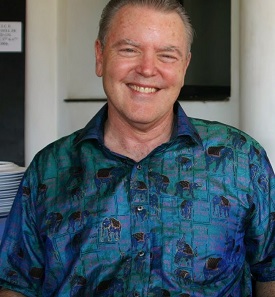
Arthur C. Clarke: A Life Remembered
$22.95 plus shipping. ISBN 978-1926837-26-0
Authors in order of first appearance: Fred Clarke, Robert Godwin, Mark Stewart, and Kelvin F. Long (multi-contributor chapters follow the chapters from the four authors in this review)
Fred Clarke
Chapter I – Childhood: Vignettes by Fred Clarke (25 pp.)
If the Guinness World Records had a category for “Devoted Brothers,” Frederick William Clarke (1921-2013), the second born son of Nora and Charles Clarke, would have held the world record since the first edition in 1955. Even so, Fred Clarke was his own man and shared with his brother Arthur a unique individuality and vitality in life. I think of the wonderful quote from Joseph Campbell: “The privilege of a lifetime is being who you are.”
Twenty-three (23) vignettes, all with titles, almost all humorous and positive anecdotes about growing up in Somerset England, introduce this accessible and many-peopled volume on the life and work of Arthur C. Clarke.
The lengths vary from 4 lines to 2 full pages—the longest including “Huish Grammar School” and “Star Gazing”; and the shortest, including “Cider Thieves!” and “Fred Enlists.”
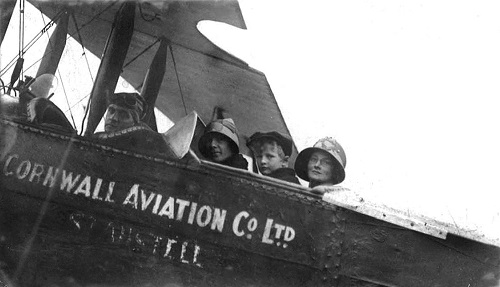
Image: Arthur C. Clarke takes his first flight in an Avro 504. Nora Clarke is in the rear seat. Captain Percival Philips at the controls. Taunton circa 1927. Credit: BIS/Apogee Prime/Rocket Publishing. Published with permission.
Great, high-end quality black and white photographs, numbering 17, appear in this chapter, and their variety ranges from portraits of Arthur’s space cadet friends and colleagues to a special plaque, attached to the stone exterior of Arthur Clarke’s birthplace at 4 Blenheim Road in Minehead. (A total of 70 photographs in the book, with 2 tables on starships in fiction.)
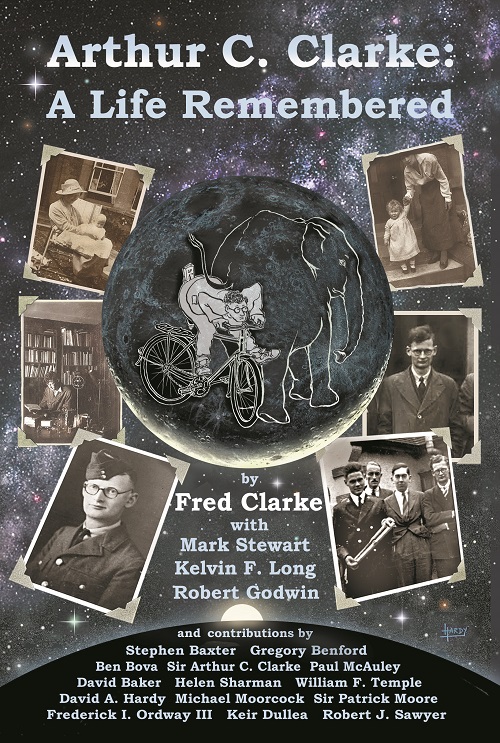
Robert Godwin
Chapter II – Early Days: From Ego to Fame (46 pp.)
Rob Godwin’s important Chapter II is a substantial contribution to Clarke’s early life, and its coverage of 20 years (1934-54) represents one-fifth of the book’s entire text. Indeed, this accessible, readable text tends to cloak its original and hard-won research from an expert and publisher in the space sciences–a devoted writer who knows the joy of discovering new treasures of a well-lived life. This labor of love also required the skills of a genealogical sleuth—tracking down, contacting, and interviewing many descendants of key contemporary influences in Arthur Clarke’s life.
After Godwin’s fine history, gold nugget pieces of reality from the early days come forth to complete the chapter via the still lasting magic of print—a time machine from Arthur’s pen and from the pen of his good friend and fellow space cadet, Bill Temple. These are three pieces from the classic fanzine, Novae Terrae, dated June 1937 (Clarke, 3 pp.), June 1938 (Temple, 5 pp.), and January 1939 (Clarke, 3pp.). Read them. They will transport you back to a time when Arthur was 20 years old.
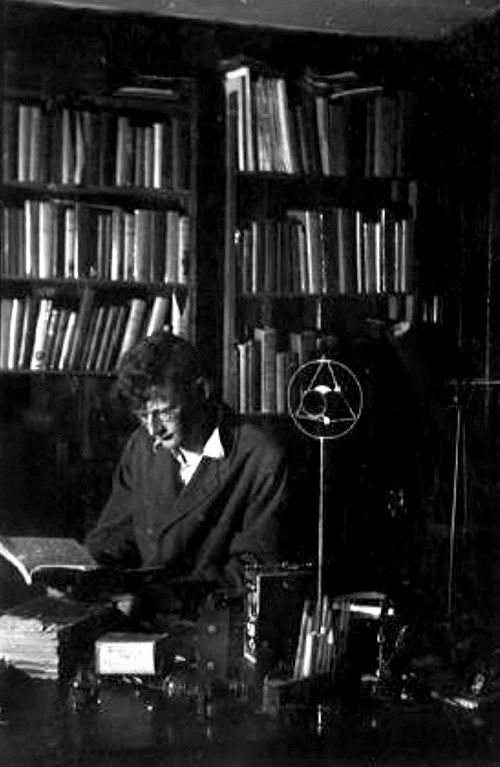
Image: Arthur C. Clarke in his study at Ballifants. Credit: BIS/Apogee Prime/Rocket Publishing.
Chapter XII — Beyond 2001: The Gala (13pp.)
And later on in the book, third to last chapter, Godwin’s dramatic and colorful account of the Arthur C. Clarke Gala at the Playboy Mansion overflows with his genuine enthusiasm and gratitude for actually being there and playing a part of moving some of the events along smoothly. This reviewer, who was also present that November night just weeks after the September 11 attack, was reminded how much he had forgotten in 12 years! But to this day, seeing the living Arthur C. Clarke, from a half world away, projected as a 3D hologram standing at a podium opposite Star Trek Commander Patrick Stewart, will never be forgotten.
Mark Stewart*
Chapter IV – The Clarke Legacy: An Interview with Fred Clarke (6 pp.)
Mark Stewart, editor of the online monthly Odyssey, meets the other brother, Fred Clarke, for the first time, when Fred is closing in on his 90th birthday. With summary narration and quotes, Stewart writes up Fred’s delightful anecdotes as only Fred Clarke can tell them, with good humor and optimism. The short tales do not overlap with those of the Fred’s first chapter.
* Mark was accompanied by BIS members Kelvin F. Long and Colin Philp.
Chapter V – Tales from Taprobane*: An Interview with Nalaka Gunawardene (11 pp.) in December 2010.** Nalaka’s interview’s timeline stretched from the latter half of the 1980s to Clarke’s death in March 2008. Nalaka handled all public relations and media work upon his death. As Clarke’s assistant of many hats, the stories and insights into life with Clarke and his work are fresh and insightful.
*In three parts, with this Gunawardene interview as part one—and the longest. All three parts share the place: Sri Lanka, aka Ceylon and Taprobane. The other two parts are: “Rendezvous with Arthur,” Michael Lennick (6 pp.); and “The Brightest Star,” Helen Sharman (2 pp.)
** Colin Philp was present at the Gunawardene interview held at BIS Headquarters in London.
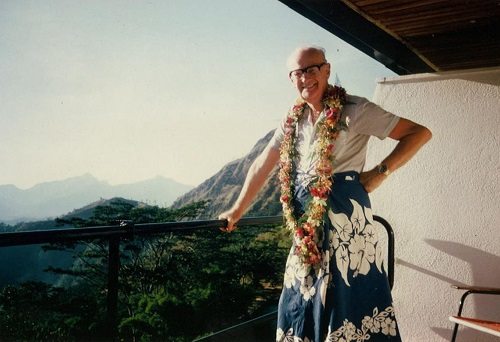
Image: Arthur in his beloved Sri Lanka. Credit: BIS/Apogee Prime/Rocket Publishing.
Michael Lennick, the producer of a Discovery television documentary on the film 2001: A Space Odyssey, writes the second part of Chapter V about his visit and interview with Arthur in 2000. He was astounded that his draft came out to exactly 2001 words! Serendipity! He left it that way—not wanting to press his luck. (5.3 pp)
And part three was written by astronaut Helen Sharman. Her narrative tells of her visit to Sri Lanka to meet Arthur and promote her book, which began with a foreword by Clarke. Sharman was the first British woman in space, who flew to the Mir Space station in 1991.( 92pp.)
Chapter X – Interplanetary Men: Arthur Clarke and Olaf Stapledon — Cosmic Visionaries (6 pp.)
Mark Stewart writes about one of Arthur Clarke’s most profound and consequential early influences in his work, Olaf Stapledon, whose books include the long-lasting, relevant, and classic novels, Last and First Men and StarMaker. Many other contemporaries of Clarke, including his lifelong friend, Patrick Moore, were equally influenced by Stapledon. And how did these “Deep Time and Space” enthusiasts get the famous writer to the youthful British Interplanetary Society to give a lecture in post-WWII 1948? Bob Parkinson, then President of the BIS, told Stewart before a lecture one night: “Clarke and a few others just went to where he was living at the time, and knocked on his front door; they just asked him to do it! …That’s how we got him to speak.”
Clarke had the honor of introducing Stapleton to the audience that evening, and Stewart gives several rare and great quotes from the lecture in this piece. A must read for the “Deep Time and Space” cadets.
Chapter XIV – Fred Clarke (2 pp.)
Mark Stewart writes this piece about the rare and wonderful lifetime relationship between the Clarke brothers who are now together forever in “Deep Time.” This heartfelt tribute of the first order has a lasting power to anyone who met and knew Fred Clarke.
Chapter XV – Fictional Last Word (2pp.)
Stewart extends the power of his tribute to Fred Clarke by flashing forward from the tribute’s last paragraph to this short, fictional image tale of the two brothers once again together.
Kelvin F. Long
Chapter VIII – Old Spaceship (3 pp.)
This chapter is divided into three sections: “The Spaceship” (Kelvin Long) – “Blueprint for a Starship” (Stephen Baxter) – “Creating a Self-Fulfilling Prophesy in Space” (Kelvin Long). Two tables appear in the chapter, one covering ACC’s spaceships in his fiction and nonfiction work; the second covering starships in the works of other science fiction writers.
“The Spaceship” is an overview introduction to the relationship between spaceships in fiction and spaceships in advanced engineering design.
Stephen Baxter’s section, “Blueprint for a Starship,” (9 pp.) is a look at the interstellar starships of the Icarus/Daedalus class, which respectively represent an ongoing and previous program of studies from the membership and associates of the British Interplanetary Society. All starship concepts in these two research programs travel at some fraction of the speed of light and none reach it. Three sample starship concepts from the final page table in Baxter’s essay give the cruise speed of the Daedalus Project as 0.12 c; Clarke’s Magellan in Songs from Distant Earth as 0.2c; and the Venture Star in James Cameron’s Atavar as 0.7c – all as speed-of-light percentages. The Table on the concluding page of Baxter’s “Blueprint” gives the neophyte starship student an excellent perspective—including the keyed references, one of which cites Paul Gilster’s Centauri Dreams (Springer 2004) as an excellent source for starships in science fiction.
Long’s “Creating a Self-Fulfilling Prophesy . . .” (6 pp.) concludes the chapter with an inspirational narrative about the many and varied ways Arthur left his mark on several generations of future space farers—what I call, “Arthur Clarke’s Deep Legacy,” in both time and space. This includes Long’s own renewed enthusiasm from Clarke’s lifetime work as well as a commitment to the interstellar vision that Long works toward, what Paul Gilster (whom I dub the “Master of the Deep”) named his book and website for — Centauri Dreams. But Long puts reality into his renewed vision by organizing the new interstellar research effort he names Project Icarus. “Where Project Daedalus showed that interstellar travel was possible in theory (proof of an existence theorem), Project Icarus aims to demonstrate it is theoretically possible in practice, not by building the vehicle but by demonstrating that the design is sufficiently credible and possible in the near-term.” And the Project Icarus mission also must fire up future generations of interstellar experts as they move into Deep Space and Time to reach new worlds.
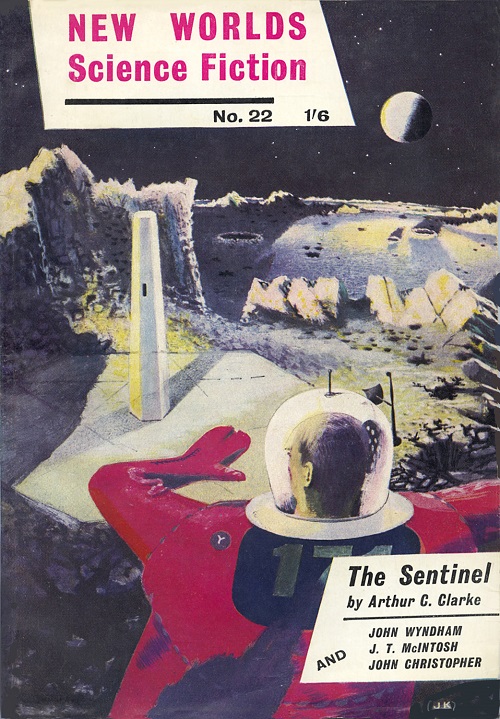
Image: Clarke’s ‘The Sentinel’ as it appeared on the cover of New Worlds in 1954. Credit: Michael Moorcock.
Chapter XI – Before the Odyssey (6 pp.)
Kelvin Long compliments Mark Stewart’s chapter X, Interplanetary Men, by covering other early literary influences in Clarke’s youth. His primary focus is on David Lasser and his classic 1931 nonfiction book, The Conquest of Space, which describes the practical applications and future prospects for humankind of rockets and rocketry. He quotes Clarke on its importance to him at the age of 14.
——-
NOTE: Front and back matter, plus multi-contributor chapters now follow. All chapters by the four primary authors have been summarized, in order of appearance, prior to this note.
——-
Front Matter Overview – Acknowledgements by the four authors. Preface by Gregory Benford: “Remembering Arthur” (3 pp.). Benford’s upfront essay joins the large starship crew of admirers and personal friends who carry forth Clarke’s lifelong desire to reach other star’s and their worlds of sentient beings; Preface, by the four authors who man the bridge of the good starship, Arthur C. Clarke, which carries the legacy of his vision to future reality. Special Introduction by Angie Edwards, Fred Clarke’s daughter and Board Member of the Arthur C. Clarke Foundation. “This is the first truly personal memoir of my Uncle Arthur. . . .”
Back Matter Overview. Resources and Recommended Reading; Selected Papers by Arthur C. Clarke, covering 43 years,1938 to 1981. About the Authors, who take the helm of the Good starship Arthur C. Clarke.
Chapter III – Friends and Followers (10 pp.)
This chapter, short and sweet, has reminiscences of 5 friends who knew Clarke over long periods of time. They are, in order of appearance, Fred Ordway (met in 1950); Michael Moorcock (met in early 1960s); Ben Bova (met in 1956); Keir Dullea (met in late 1965), and writer Robert J. Sawyer (who met ACC only through his work–he read 2001: A Space Odyssey when he was 11, in 1971, but saw the movie when he was only 8, in 1968.
For the “general reader,” who might not be familiar with one or more of these five space cadets, there is a succinct mini-bio is at the end of each piece.
Chapter VI – Remembering Arthur: Members of the British Interplanetary Society Reminisce (12 pp.)
Seven members of the BIS tell their personal tales and connections to Arthur Clarke. In order of appearance they are:
- Martin Fry (Chair of the Space 82 BIS Conference in Brighton who interviewed Clarke via satellite link)
- David A. Hardy (Studied sciences at the College of Technology in Birmingham and met Arthur Clarke when he lectured there for the BIS in the early 50s)
- Mat Irving (The great model maker for BBC Television, Arthur’s friend, and BIS member, who last saw Clarke in 1999, at the British Film Institute showing of Kubrick’s remastered 2001 film print.)
- Bert Lewis (Met Clarke when he was a young student at Taunton Grammar School. Many years later in 1955 he stayed with Bert and his wife when on a lecture tour. The couple were challenged to get him to the dinner table because Arthur was completely engrossed in Bert’s great science fiction collection)
- Kelvin F. Long (Met Clarke at the London Science Museum in 1999. A fellow was pointing up to an exhibit, Arthur C. Clarke invented the communications satellite, and the man turned out to be Arthur. Kelvin and friends talked briefly with Clarke, and this changed Kelvin’s his life, which is now devoted to “rejuvenating the study on interstellar flight”)
- Sir Patrick Moore (Met Arthur at BIS when he was 12 and Arthur was 17—in 1934. They were fellow enthusiasts and both became great men in the space and astronomy fields. They were friends for 74 years!)
- Ray Ward (One of the great fans of Arthur C. Clarke, who met Arthur for the first time in 1971, when Clarke was in London and delivered a lecture at the BIS headquarters.)
- David Baker (Fellow of the British Interplanetary Society and currently the editor of its magazine, Spaceflight. He recalls the fascinating details of Kubrick’s advance men mining NASA’s concept and project art to supply realism to the film. Dr. Baker worked in the US space program for more than 25 years, and spanned the early days of the Gemini program, through the years of Apollo mission planning and with the Space Shuttle program during the 1970s and 80s. He’s been a genuine space cadet throughout his full career.

Image: Brighton 1987. David Brin, Fred Clarke, Charles Sheffield and Robert Forward. Credit: BIS/Apogee Prime/Rocket Publishing.
Chapter VII – Treading the Sands of Mars: Arthur’s work in Retrospect (20 pp)
Eight book reviews, one review of current state of space exploration, written by 7 reviewers, with Adam Crowl and Mark Stewart writing two each. One novel, The Sands of Mars, is reviewed twice, and the review is of a limited edition which presents his teenage writings. The reviewers are, in order of appearance:
Kelvin F. Long – The City and the Stars
John Silvester – The Sands of Mars
Adam Crowl – The Sands of Mars
Gregory L. Matloff – Childhood’s End
Paul McAuley – Rendezvous with Rama
Adam Crowl – Earthlight
Mark Stewart – 2001: A Space Odyssey
Andy Sawyer – Childhood Ends (Not the famous 1953 novel, but ACC’s teenage writings)
Mark Stewart – “Arthur’s Guide to the Universe” (A review of the current state of the planet’s space-faring, as seen through the works of Clarke)
Chapter IX – Father to the Man – Stephen Baxter (8 pp.)
“We seem to be young, in a very old Galaxy. We’re like kids tiptoeing through a ruined mansion.” — Stephen Baxter, Ark
And Arthur Clarke was the first kid in line to open up the doors that still were on their hinges. This piece by well-known novelist Stephen Baxter is a wonderful tribute from a successful and grateful author who was brought up on Clarke’s novels, stories, and nonfiction science writings.
There are many insightful personal and professional expressions of his late-in life friendship with Arthur Clarke, and the concluding paragraph of his essay is one of the best.
“A writer’s early works, before experience and craft take over, can be a richer expression of his/her deepest influences and subconscious yearnings than later material. By returning in his and later life to visions from his boyhood, Clarke was revisiting the wellspring of his own creativity.”
Chapter XII -Later Days: 90th Birthday Reflections* (3pp.)
This three-page transcript is Arthur C. Clarke’s last media appearance that was uploaded to YouTube one week before his 90th birthday — on December 9, 2007. His assistant, Nalaka Gunawardene, made this significant event happen — once he approached Arthur and got a high-sign go ahead. Its first appearance, recalls Nalaka, “made some international news and soon became a hit on You Tube.” My bet is that all Clarke fans alive today have seen this broadcast at least once, and millions of other viewers around planet Earth also saw Arthur Clarke and heard his final goodbye to the world.
*Readers who wish to know more about the “back story” of this final media appearance should refer to Neil McAleer’s definitive biography, Visionary: The Odyssey of Sir Arthur C. Clarke, chapter 44, “Two Media One Last Time.” (The eBook edition of this biography, published by RosettaBooks, is retitled as Sir Arthur C. Clarke: Odyssey of a Visionary, which has a new preface.
The Reviewer now humbly titles the review, The Good Starship Arthur C. Clarke, with the four authors on its bridge, taking the helm in turn. And there are 30 other crew members, all important to the mission of the good starship Arthur C. Clarke.
Beautiful night last night. Southern Cross
(a very feeble constellation) just above the
front gate, with Alpha Centauri beside it.
It always gives me an odd feeling to look
at Alpha and to realize that’s the next stop.
–Letter to Val Cleaver, 1955
——-
Arthur C. Clarke: A Life Remembered
$22.95 plus shipping. ISBN 978-1926837-26-0
Available from Apogee Prime Books through the links below.
http://www.apogeeprime.com/prime/bookpages/9781926837260.html
http://www.bis-space.com/2013/06/25/11092/out-now-arthur-c-clarke-a-life-remembered
This last link is the original announcement from Apogee Books
http://www.cgpublishing.com/9781926837260.html



A brilliant summary! Much looking forward to this book.
Thank you for this review. I have ordered a copy for my “Clarke library”.
OT – the New Worlds cover art illustrator ignored the pyramid shape described in the story and just put in something rather different, rather more like a crystal.
I love the 3rd picture, down in the right hand corner is midshipman Robert Truax holding a rocket motor , I think he built for the BIS.
Captain Truax , after 20 years in the Navy he worked for Aerojet and then had his own company Truax Engineering. As a young ‘space cadet’ I knew of Truax’s technical work in rocket motors , one of my heroes.
In 1978 I was working for the Air Force ‘s Blue Cube near Sunnyvale Calif…. I and the family lived in Blossom Hill south San Jose, and Truax lived only a mile or so from us, every now and then I drove by his house. Much to my amazement I would see parts of X-3 Volksrocket sticking out of his garage!
I was an officer in the local AIAA section and we decided to have a special dinner celebrating the 75 anniversary of the Wright Brothers first flight.
Since Robert Heinlein lived in nearby Santa Cruz , fell to me to try to get him.
With great difficulty I got his snail mail address and wrote him a letter. Much to my surprise Heinlein called me to apologize that due to his brain operation he could not make it.
I was stuck for a while till I remembered Truax, he came and gave a rousing talk about the Volksrocket!
I got to talk to him a little, but was amazed to find out his connection to the BIS and Clarke a few years later, I should have known!
Charming man and rocket pioneer.
If you are in the DC area, and would like to go to the Arthur Clarke awards October 22, I believe they still have some (free) tickets available :
http://www.clarkefoundation.org/events/2013-arthur-c-clarke-awards/
The 2013 awards are going to Ursula Le Guin, Mark Dankberg and Fred Ordway III.
(Note : this is the ACC _Foundation_, and these awards are totally separate from the ACC Science Fiction Awards in the UK.)
Al Jackson writes:
Al, that story is priceless! Thanks. Made me think we were back in Dallas talking SF and science at the rooftop restaurant.